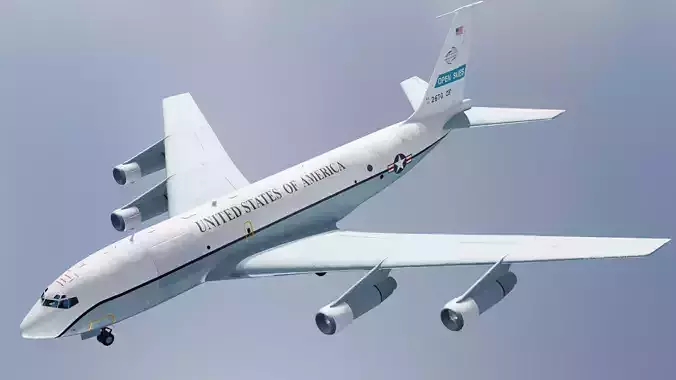1/44
Perfect for use in games and simulation projects.
The OC-135B Open Skies is a highly specialized reconnaissance aircraft operated by the United States Air Force, developed to support the implementation and enforcement of the Treaty on Open Skies. This treaty, which was signed in 1992 and entered into force in 2002, was created as a confidence-building measure among participating nations, allowing for unarmed aerial surveillance flights over the entire territory of other signatory states. The purpose of the treaty was to enhance mutual understanding, foster transparency regarding military forces and activities, and reduce the risk of conflict through cooperative observation. Under this agreement, nations could request and conduct scheduled observation flights, with all parties agreeing on flight paths, equipment, and data sharing protocols.
The OC-135B is based on the Boeing WC-135B airframe, which itself derives from the versatile C-135 aircraft family that includes other variants like the KC-135 Stratotanker and RC-135 reconnaissance platforms. The airframe was extensively modified to suit the unique demands of treaty compliance and observation missions. Unlike its tanker or intelligence-gathering counterparts, the OC-135B carries no refueling equipment or electronic eavesdropping systems. Instead, it is outfitted with an array of specialized cameras and sensors designed for aerial imaging. These include the KS-87E framing cameras positioned to capture low- and high-altitude photographs, the KA-91C panoramic camera mounted to scan wide swaths of terrain from high altitude, and an infrared line scanner that can be employed to detect heat signatures and other thermal data during flights. All of these systems are operated according to treaty guidelines to ensure transparency and compliance, with no hidden surveillance capabilities allowed beyond what is agreed upon internationally.
A typical mission aboard the OC-135B involves a crew of approximately 35 personnel, which includes pilots, navigators, camera operators, technical support staff, treaty compliance officers, and official observers from both the United States and the country whose territory is being observed. The presence of observers from the host nation during flights is a requirement under the treaty to ensure that all data collection remains within the scope of the agreement and that no unauthorized intelligence gathering occurs. Flights are carefully planned and coordinated in advance, with flight paths, altitudes, sensor operation times, and other mission parameters being negotiated and approved through diplomatic channels before the aircraft even leaves the ground.
Throughout its operational history, the OC-135B played a critical role in promoting international transparency and arms control verification. Its missions allowed participating countries to confirm each other’s military activities and force deployments, providing reassurance and reducing suspicions that could otherwise escalate into conflict. The data collected during these flights was shared equally among treaty members, further reinforcing trust and cooperation. The OC-135B was primarily stationed at Offutt Air Force Base in Nebraska, where it underwent maintenance, crew training, and mission preparation between flights.
However, the aircraft’s future became uncertain following political shifts regarding the treaty’s value and effectiveness. In 2020, the United States formally withdrew from the Treaty on Open Skies, citing concerns over compliance by other nations and broader national security considerations. This withdrawal meant that the OC-135B was no longer required for its original mission under treaty obligations. In the years that followed, discussions emerged about retiring the aircraft or repurposing it for other roles, though its highly specialized equipment made conversion into other operational platforms a complex and costly proposition.
The OC-135B remains a symbol of a unique period in international relations, representing an era when transparency through cooperative surveillance was seen as a key tool for reducing the risk of military conflict. Its missions offered a rare opportunity for adversarial nations to observe each other’s territories openly and with mutual consent, fostering communication and reducing uncertainty. As arms control treaties evolve and the geopolitical landscape continues to shift, the legacy of the OC-135B stands as a testament to both the potential and the challenges of international verification efforts through aerial observation.
Formats include: OBJ, FBX. Feel free to check out the other models, just click on the user name to see the complete portfolio.
REVIEWS & COMMENTS
accuracy, and usability.












































